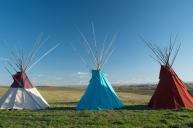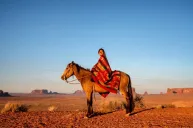Though tourists may not know this, many Indigenous tribes have a long history with the nation's national parks. They were sacred sites, homes, and ceremonial sites. A new project is hoping to shine a light on that and also help compensate tribes in the area as well.
"A lot of different tribal nations conduct their fasting ceremony or vision-questing ceremony here," Chase Iron Eyes, director of Lakota People's Law Project told USA Today of Bear Butte State Park in South Dakota. "My grandmother used to bring me here when I was tiny."
The law project launched its Sacred Defense National Parks and Monuments Initiative. The initiative encourages visitors and supporters to donate. They can pick a park or monument site, and those funds will be distributed to associating tribes in the area. Through the initiative, tribes hope they can share their own histories with national parks.
"All national parks sit on native lands," said Brooke Neely, a research fellow at the Center of the American West at the University of Colorado Boulder. "The very creation of U.S. national parks was part of the larger project to displace and dispossess native people of their lands."
They want visitors to participate in these national parks like the tribes do.
National Parks Project
"When you visit Devils Tower, or, as we know it, Mato Tipila, we want to tell you our stories about it," Iron Eyes says in a video posted on the initiative's website. "We don't want you to just read some one-pager at the interpretive center. We want you to experience these sacred sites, sacred lands and sacred waters as we do."
So far, the Sacred Defense initiative launched in 14 national parks. They plan to add more national parks over time. The funds will be distributed to participating tribes on an annual basis.
"National parks are often landscapes of exceptional awe and wonder, so it makes sense that Indigenous people appreciated the power of those landscapes long before European and European-descended peoples set foot in those landscapes," said Christine Gish Hill, an associate professor of American Indian studies at Iowa State University in Ames.
As part of the project, Iron Eyes wants to promote conservation in these areas.
"There are bountiful ecosystems that are here, and we have a duty to protect them," Iron Eyes said. "Can they be resourced, developed? Yes - but responsibly."




